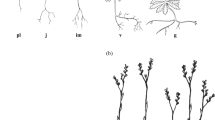Abstract
This paper extends Leslie's vector and matrix treatment of populations. A simple matrix is given for species in which adult mortality and fertility are independent of age, but in which the juvenile mortality rate differs from the adult. The population vector can be changed into a population matrix. This should allow equations using functions of the size of the population to be developed. Genetic variables such as sex or other polymorphisms can be introduced, and the notation allows different systems of selection or non-random mating to be specified.
Similar content being viewed by others
Literature
Capildeo, R. and J. B. S. Haldane. 1954. “The Mathematics of Bird Population Growth and Decline.”J. Anim. Ecol.,23, 215–23.
Leslie, P. H. 1945. “On the Use of Matrices in Certain Population Mathematics.”Biometrika,33, 183–212.
—. 1948. “Some Further Notes on the Use of Matrices in Population Mathematics.”,35, 213–45.
Lewis, E. G. 1942. “On the Generation and Growth of a Population.”Sankhya,6, 93–6.
Author information
Authors and Affiliations
Rights and permissions
About this article
Cite this article
Williamson, M.H. Some extensions of the use of matrices in population theory. Bulletin of Mathematical Biophysics 21, 13–17 (1959). https://doi.org/10.1007/BF02476455
Received:
Issue Date:
DOI: https://doi.org/10.1007/BF02476455




